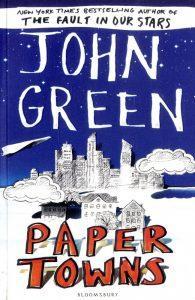“The longest day of my life began tardily. I woke up late, took too long in the shower, and ended up having to enjoy my breakfast in the passenger seat of my mom’s minivan at 7:17 that Wednesday morning.”
Who is the real Margo?
Paper Towns is John Green’s fourth novel. Originally published in 2009, it recieved mixed reviews. Labelled as “another teen pleasing read”, the novel has been hailed a success as well as well as a disapointment.
Drawing inspiration from the author’s own experience with fictional places, Paper Towns explores unrealistic expectations, two-dimensional characters, and illusion versus reality.
Summary
The story follows Quentin Jacobson over the final three weeks of high school. When his neighbor, and long-time crush, Margo Roth Spiegelman climbs through his bedroom window, he’s yanked into a world of mystery and perception. The next day, however, Margo Roth Spiegelman is reported missing. Q is left scrambling for answers as he desperately tries to make sense of the clues she left behind. Jumping from paper town to paper town, working through the works of Walt Whitman, and examining potential-suicude notes, Q frantically tries to find Margo before it’s too late. But is the idea of Margo Roth Spiegelman different from the girl herself?
Commentary
Paper Towns is a carbon copy of Green’s other novels, most noticeably Looking for Alaska and An Abundance of Katherines.
Praise
- The book deals with many important themes that all teenagers need to deal with at some point in their life. Issues of identity, of belonging, of loneliness. It explores the difficulty of leaving bad situations and how sometimes the idea of someone isn’t as good as the person themselves.
- It has a realistic ending. There is no dramatic movie scene running in slow motion just before the grand finale. It’s real. The characters have changed throughout the course of the novel, and thankfully, the ending reflects that. They don’t have a movie scene ending simply because that’s not who there are anymore.
- Green has a unique and interesting writing style. The story seems to flow from scene to scene, and even plot twists and cliffhangers aren’t as disjointed as most other novels. There are numerous quotable lines in the book that have already found their way on Tumblr posts and t-shirts, and it makes the novel easy and enjoyable to read.
Critique
- As I said, it’s nearly identical to Green’s other novels. It follows the same plot formula. It has the same nerdy boy and quirky girl. There are even obscure metaphors that act as philosophies for life. If you’ve read one John Green book, then you’ve read them all.
- The characters are beyond one-dimensional. Q is timid and nerdy and “out of his league”. Margot is otherwordly and unique and “unattainable”. Q’s best friend, Ben, is the stereotypical sidekick; a supposedly funny but obnoxious ride-or-die despite having nothing in common with the main character. The characters are flat and dull and as fake as the paper towns the novel is based on.
- There are so so so many discriminating remarks and situations in this novel. Rader, the token black friend who says as much, the frankly disgusting comments Ben makes about women, and even Q, the so-called “nice guy” who still objectifies and demands love from a girl who has never shown him the slightest hint of affection.
Recommendations
Overall, I’d give John Green’s Paper Towns a two out of five. Although it has some aspects of a good mystery, it’s mostly made up of sexist remarks and nice guys whos spend half the time complaining about not getting the girls they regularly leer at.
I’d recommend this novel to nobody whatsoever unless you happen to enjoy young adult stereotypes. Its sense of mystery and adventure is its only redeemable feature because the characters are honestly deplorable.

Want to read it for yourself?
Prefer to listen instead?
